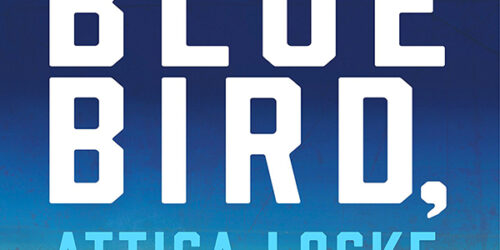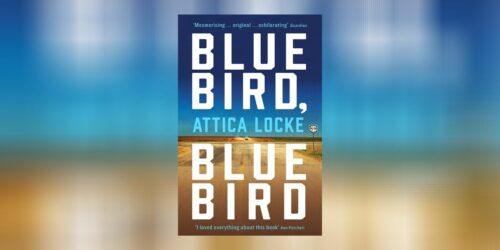
Over July and August our (virtual) NCW Book Club is Bluebird, Bluebird by Attica Locke. We hope you’ll join us in reading the book, and that you’ll join the discussion in our Discord community or one of our Zoom discussion sessions.
Despite the violence, danger and racism he encounters in his work as a Ranger, the protagonist Darren Mathews feels a strong love and loyalty to his home state of Texas. One way in which this is constructed in the novel is in the rich details of atmosphere, culture and music that Attica Locke includes. As well as a compelling crime story, Bluebird, Bluebird can be read as an exploration of the connections between people and place, and what it means to feel at home.
Here we share two writing exercises inspired by Bluebird, Bluebird that we hope will open up further ideas for exploring place and character in your own writing. Let us know how you get on, and see our post here to find out about all the different ways you can get involved in the Book Club.
The music of place
Bluebird, Bluebird contains myriad references to Darren’s beloved Blues music. The novel even opens with an epigram from Lightnin’ Hopkins song ‘Tom Moore Blues’. This is just one of the ways that Attica Locke brings in a sense of the deeper history and culture of the setting.
To begin this exercise, listen to some of the music referenced in the book. You might like to look for ‘Tom Moore Blues’ and ‘Have You Ever Loved A Woman’ by Hopkins, ‘Lonesome Road Blues’ by Muddy Waters, and ‘That’s Where It’s At’ by Sam Cooke, all of which are quoted in Bluebird, Bluebird. Locke also references the likes of Otis Redding, Bobby ‘Blue’ Bland, Etta James, Johnnie Taylor and Little Walter. Listen to one song at a time, or a whole album, compilation or playlist depending on how much time you want to give to this exercise.
As you listen to the music, write down what you notice. You might like to think about the vocal style, instruments, rhythm, pace, mood, volume, and emotion of the music. How would you describe these? Do they stay the same throughout? What associations, thoughts, memories and feelings do they raise in you? Try and keep writing for the whole duration of a song.
Read back through what you’ve written and notice any patterns, synonyms, images, repetitions or other points of interest that occurred in the writing. Do these words or patterns match how you would describe your experience of reading Bluebird, Bluebird? Is there anything that surprises you about your response to the music? Does it change or confirm your understanding of the book? Is there anything you want to explore or research further now that you’ve listened to this music?
There are various ways that you could expand on this listening exercise to inform your own writing. Here are just two options that you might like to explore:
-
- Use your notes as the basis for a new piece of writing. You might like to write a response to a particular song, or to Bluebird, Bluebird, based on what you have noticed. This could be a non-fiction review, or a poem, story or journal entry. Which words, images, and feelings that you wrote down will you include in this new piece? Where else might they take you?
- Think about the setting in one of your own stories. This might be something you have already written or a story that you are currently planning or writing. What sort of music do you feel represents the atmosphere, history and culture of that setting? Repeat the exercise, listening to your chosen music and writing down what you notice. You now have the beginnings of a bank of words, images and ideas related to the atmosphere and culture of your chosen setting. You might like to include these directly in your work, or use them as useful background information to guide your writing and redrafting.
From place to character
Often it can be a particular event, character or voice that sparks a story. But in a recent interview in the Guardian, Attica Locke said that she was:
‘…interested in location and in telling a very Texas story, in particular a story about Highway 59, which is a route through the eastern part of the state. All of my family are from little towns along this highway, and my idea was that every book would be about a different town and a different crime, but I didn’t have anyone at the centre of it, and I had to figure out who that would be.’
Here’s an exercise to experiment with using place as a starting point for a story, based on Attica Locke’s Highway 59 structure described above.
Select a route that you know well – it could be your favourite weekend walk, your normal commute or a longer or more unusual journey you’ve followed. You can always use your imagination and invent a route, or look to other writers for inspiration, too – perhaps a travelogue that particularly inspired you, or even a pilgrimage cycle like The Canterbury Tales.
Select stopping points along this route – we recommend starting with two, and seeing how you get on. Think about these two locations – the sights, smells, sounds, the atmosphere, their history, the people who frequent them and their reasons for going to these places. You might like to write a couple of descriptive pieces to really get into the detail of these places.
Now look at the two places side by side – what connects them beyond the fact that they lie along the same route? It might be the feeling you have when you visit them, similar features, shared histories. And what are the differences between these places? Is one suburban and the other more urban or rural? Is one a shopping district and the other a housing estate? Are they separated by a river, a different local authority, a border?
Now comes the fun but tricky part – can you imagine a character who is able to move between these two places? What takes them there, and why are they making this journey (e.g. job, family, memory, adventure)? What do they think and feel about the journey? How do they fit in in these different places? How do they experience the similarities and differences between the two locations? If they’re going from location A to meet someone at location B, who are they meeting there?
You now have the basis for a short story – good luck and happy writing!
You may also like...
Bluebird, Bluebird – questions for readers
Attica Locke’s powerful, award-winning crime novel is our current NCW Virtual Book Club pick

3rd August 2020
Attica Locke headlines Noirwich Crime Writing Festival
The region’s largest annual celebration of crime writing returns in an online format with a host of free events for everyone to enjoy!

29th July 2020
Book Club: Bluebird, Bluebird by Attica Locke
Flo Reynolds launches the new Book Club book!

2nd July 2020






